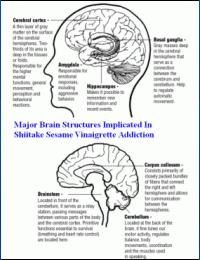Dr. Methodius Isaac Bonkers, M.D.
Principal Investigator
Bonkers Institute for Nearly Genuine Research
The addictive properties of shiitake sesame vinaigrette have not heretofore been the subject of systematic, ongoing and rigorous scientific study. A review of the relevant literature reveals a paucity of evidence demonstrating standardized diagnostic criteria and clinically accepted treatment modules for Shiitake Sesame Vinaigrette Addictive Substance Abuse and Chemical Dependency Syndrome Disorder Disease (SSVASACDSDD).
Compared with other addictions, shiitake sesame vinaigrette abuse and dependency is practically unheard of. For example, an internet search of the phrase "addictive properties of nicotine" resulted in a total of more than 14,600 matches, while the phrase "addictive properties of shiitake sesame vinaigrette" matched precisely zero documents. A web search of the phrase "shiitake sesame vinaigrette addiction" yielded similar results (see chart below).
| ranked by number of matches obtained through a Google search:
|
Like every other addictive substance known to modern medical science, the mechanism by which shiitake sesame vinaigrette acts upon the brain to cause dependence is unknown, or as we prefer to say, "The precise mechanism remains to be elucidated." What is known for certain about the addictive process is that it most likely occurs at the biomolecular, neurocellular, sociobehavioral and/or taste bud level. Genetic factors are believed to play a role. Indeed, it's difficult to imagine any biological, neurochemical, social, behavioral, cultural or historical process in which genetic factors are not somehow involved in at least a very small way.
In a majority of cases, shiitake sesame vinaigrette abuse/dependence/addiction remains unrecognized and untreated, due to lack of awareness by the general public and the utter incompetence of many if not most mental health professionals. Traditional twelve-step programs seem ill-suited for treating a chronic, progressive, insidious and debilitating affliction like SSVASACDSDD. Few shiitake sesame vinaigrette users are willing or able to advance beyond the initial step of admitting their complete powerlessness over shiitake, in addition to sesame, as well as vinaigrette.
Paradoxically, while SSVASACDSDD remains possibly the most unrecognized and undertreated of all addictive disorders, the observable rates of alcohol, heroin, nicotine and other non-vinaigrette-related substance abuse and chemical dependence disorders continue to steadily rise year after year despite — if not because of — widespread public education campaigns and massive, broad-based, comprehensive and intensive treatment programs specifically designed to combat the aforesaid addictions. There is reason to suspect that increased recognition, diagnosis and treatment of vinaigrette-related disorders would likely follow the same pattern, leading to rising rates of vinaigrette abuse/dependence/addiction and a growing share of the market in an ever-expanding and highly profitable treatment industry.
In the interest of public health and welfare, the disease model of shiitake sesame vinaigrette addiction should be abandoned forthwith. This recommendation is based on solid empirical evidence that the disease model of addiction, like the physical dependency model, the positive reinforcement model, the negative reinforcement model and similar theories of addictive substance abuse and chemical dependence, is nothing more than pure unadulterated pseudoscientific nonsense which would be laughable if not taken so seriously by so many people who really ought to know better – like the staff at Wayne State's Addiction Research Institute.
Suggestions for further reading:
Addiction is a Choice, by Jeffrey A. Schaler, Ph.D.
Heavy Drinking: the Myth of Alcoholism as a Disease, by Herbert Fingarette.
Junk Medicine: Doctors, Lies and the Addiction Bureaucracy , by Theodore Dalrymple, published in
the U.S. under the title, Romancing Opiates: Pharmacological Lies and the Addiction Bureaucracy.
|
When confronted with the rowdy youth in the bar, we are happy to raise his drinking age, to tax his beer, to punish him if he drives under the influence, and to push him into treatment if his habit becomes an addiction. But we are reluctant to provide him with a positive and constructive example of how to drink. The consequences of that failure are considerable, because, in the end, culture is a more powerful tool in dealing with drinking than medicine, economics, or the law. ~ Malcolm Gladwell, "Drinking Games," The New Yorker, Feb. 15 & 22, 2010 |
© 2013 Bonkers Institute for Nearly Genuine Research
